3.8.2. Parking. Rules for drawing and adding attributes.
3.8.2.1. Rules for drawing parking spots
When drawing parking:
3.8.2.1.1
-
Draw
Parking
items using placemarks (although some parking lots should be drawn asTerritory
items — see point 3.8.2.1.1.4). Parking items include the following:3.8.2.1.1.1
-
Underground and roof parking. Put the placemark at the entrance (entrances) to the parking lot, excluding stylobates (draw parking lots on them similarly to parking lots along roads). If the entrance is a separate structure, it is drawn as a building of the appropriate type (see Section 3.4. Buildings).
If the entrance to an underground parking lot is located at a certain distance from its actual location, the placemark is drawn at the beginning of the entrance.
In the picture, the actual entrance to the underground parking lot is on the other side of the hill, which is marked with a red arrow:

If the parking lot is located on the roof of a building in the
Structure, building
category, and you can draw the road leading to the roof (see section 3.3.1.1.6), then the parking lot is not assigned theindoor
attribute and can be drawn as a polygonal item if it has a designated area.If the rules prohibit drawing the entrance to the parking lot, use a parking placemark with the
interior
attribute without drawing a polygonal item.Don't draw the territories of underground parking and roads on them.
However, if the parking is located on the first floor of a building and that floor is non-residential, you may draw the road leading to it:

3.8.2.1.1.2
-
Put a placemark at the entrance to parking in buildings (including multi-level in special buildings) and also public parking that occupies part of a building. The building polygon is drawn in accordance with the rules for mapping buildings (see Section 3.4. Buildings).
If the entrance to a parking lot inside a building is located at a certain distance from its actual location, the placemark is drawn at the beginning of the entrance.
To learn more about drawing roads in parking areas, see section 3.3.1.1.6.
3.8.2.1.1.3
-
Draw expanded sections of roadways (parking pockets) and places located along driveways that are designated for parking and marked using road markings or road signs as parking spots on Class 8 roads except when they are official taxi stands. Draw parking lots along roads of class 7 and higher where more than one car can be parked in a row as parking placemarks.
Regardless of road markings, draw parking pockets in front of building entrances as parking lots if cars parked on them don't block access to building entrances, garbage collection points, or other yard infrastructure items:
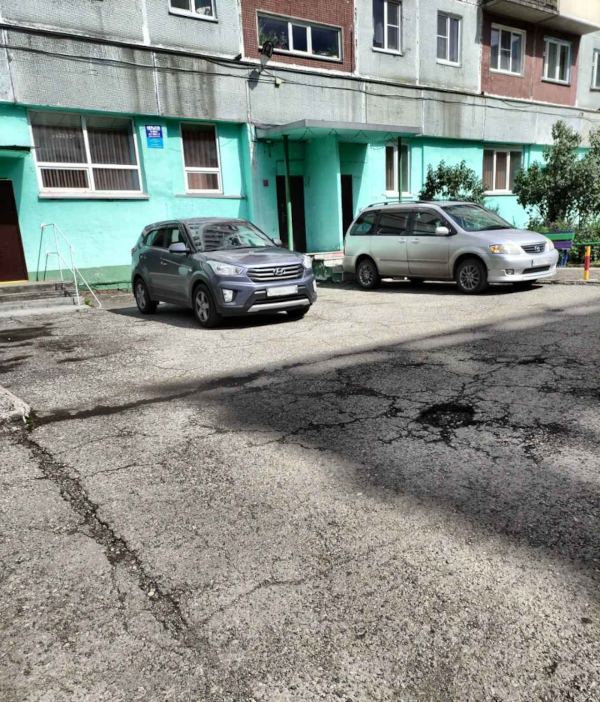
Placemarks for extended parking areas that are located along a class 8 road and that are not displayed on the map as an area item should be mapped at the geometric center of the specified parking.
Note
Map unpaved parking areas if there is a physical sign indicating parking or the area is clearly designated for parking and restricted by a boom gate, chain, fence, or otherwise.
3.8.2.1.1.4
-
Territories that are specially designated for parking and are not roadways are designated with placemarks. Usually these are designated lots on the territories of organizations, malls, office centers, residential courtyards or between residential buildings and have entrances/exits.
-
These placemarks are put approximately in the center of the parking lot if there are multiple entrances to the lot (even if one or more of them are dead ends, meaning you have to cross the lot to reach the general road network):

-
Put it at the entrance to the parking lot if there's only one entrance. The parking icon should be aligned with the relative road network section.
In the cases mentioned above, in addition to the parking placemark, you may also draw a polygon of the Territory category, type
Parking
(parking spot is set for this territory as the main organization):(see Section 3.7.2. Rules for adding attributes to territories, paragraphs 3.7.2.1, 3.7.2.2):

You can use polygonal items to display:
-
Parking lots accessible via dead ends intended solely for traffic within the parking lot:

-
Pockets
for perpendicular parking on both sides of through-block driveways (drawn as one polygonal item).
-
Pockets
, for perpendicular parking with two or more rows located on one or both sides of the road. -
dead-end extensions of through-block driveways (not to be confused with
parking pockets
):
Examples of parking lots that are not drawn as polygons:


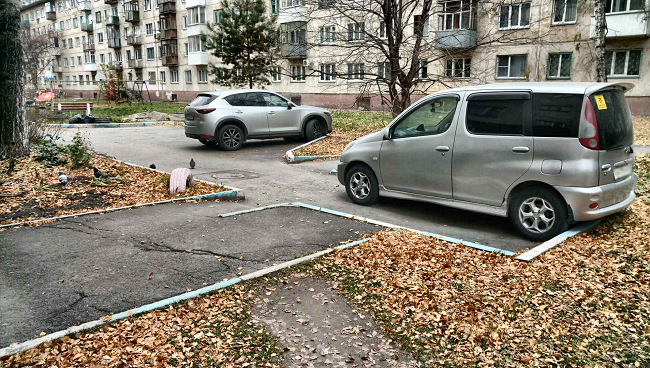
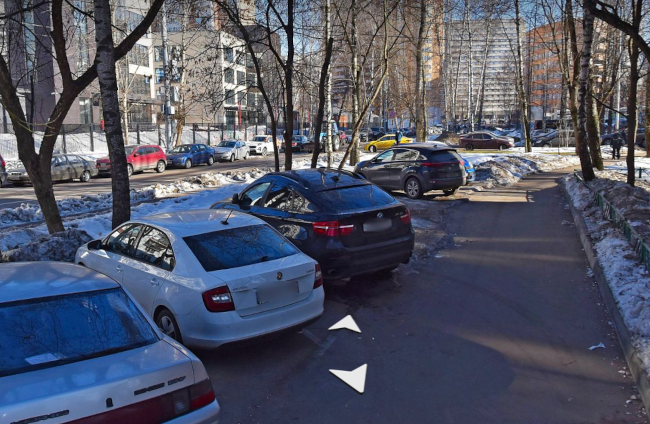
Note
Always link the polygonal parking of the
Territory
category to a parking placemark.For more information on drawing polygonal items, see Section 3.7.1. Rules for drawing territories.
-
-
3.8.2.1.2
- The techniques for drawing and editing parking lots are similar to the techniques for drawing and editing all places on Yandex Map Editor. See Section 2.5. Places.
3.8.2.2. Rules for adding attributes to parking
The attribute panel for a parking lot looks like this:
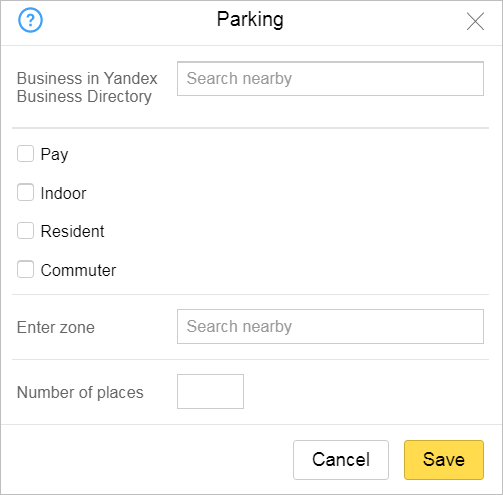
Rules for adding attributes to parking lots:
3.8.2.2.1. Pay
-
Check the box if the parking lot is paid.
Parking lots that are part of the city's paid parking network are mapped as
Parallel parking
items except for those located along class 8 roads that should be mapped using a polygon with a point according to the rules:
Don't map parking spots without polygons that have the payment feature enabled. Draw them as parallel parking lots.
3.8.2.2.2. Resident
-
Check the box if the parking is for residents.
Residential parking includes parkings:
-
That can only be accessed by residents who live in the house(s) adjacent to the parking, employees of organizations, and so on.
-
Intended either only for the disabled or not intended for passenger vehicles (motorcycle parking, truck parking, and so on).
Entry to resident parking is restricted by a pass, permit, physical barrier, or informational sign.
For example, fenced parking lots of various organizations, underground and aboveground parking lots at residential buildings that are equipped with gates or boom gates and intended for the residents of the specified buildings.
-
-
Parking lots are only considered resident if most of their parking spaces are restricted to residents.
Alert
If a parking is located within an area restricted by a boom gate, it's assigned the Resident attribute, provided there is no evidence in open sources that it's intended for the general public (such as the case with parking lots at shopping centers, airports, and so on).
-
Note
Separate handicapped parking spaces in public or restricted parking areas are not drawn as places. You can only draw them in
Indoor maps
andParallel parking
layers provided they meet the drawing rules. -
For resident parking,
don't check
** the paid box**.
3.8.2.2.3. In building
- Check this box if the
Parking
item represents the entrance to an underground parking lot or parking that partially or completely occupies the building.
3.8.2.2.4. The number of places
- Enter the number of parking spots.
3.8.2.3. Linear parking: rules for drawing and adding attributes
3.8.2.3.1
- Draw lines of parking spots as simple linear items.
3.8.2.3.2
-
Only draw lines of parking spots:
- Within localities.
- Along roads of classes 1–7 when there are road signs directly forbidding/permitting/restricting parking, or if there are dedicated parking spaces where single-row parking is permitted.
- In cities along public paved class 1–7 roads, provided you follow the signs and markings (or refer to the traffic rules if there aren't any signs).
- Along class 8 roads if they are part of an urban paid parking network or official taxi stands. In this case, don't duplicate the parking lots as places and area items (unless that is required by the general drawing rules, for example, if cars can't be parked in multiple rows, and so on).
Always draw linear parking areas, even if there is a linear parking sign, except for cases described in section 3.8.2.3.5.
3.8.2.3.3
-
When drawing lines of parking spots, you must make sure that their shape corresponds to that of the road network on the map (since the satellite image may be outdated). If you need to align parking boundaries with the boundaries of a bridge or tunnel, determine the boundaries of that structure in accordance with section 3.3.2.6.1.
If there are different types of parking in the same general area, draw them separately (blue arrows):
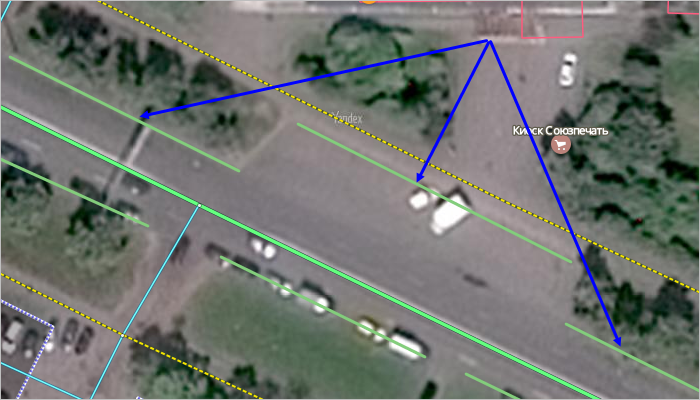
On class 1-7 roads, draw all types of linear parking lots, including parking pockets, along the edge of the corresponding markings, except for prohibited parking lots. Draw those along the edge of the roadway.
The part of a parking lane that's parallel to the main course of the road should be drawn as parallel parking (all perpendicular or inclined parts of parking lanes shouldn't be included as part of any type of parallel parking).
Correct
Incorrect
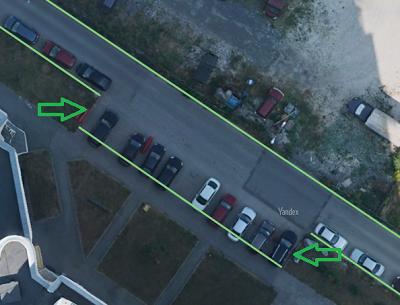
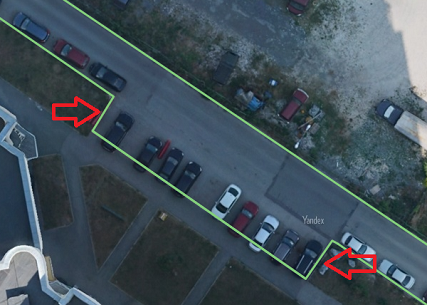
Roadway extensions before an intersection should be included into the parking area.
Correct
Incorrect
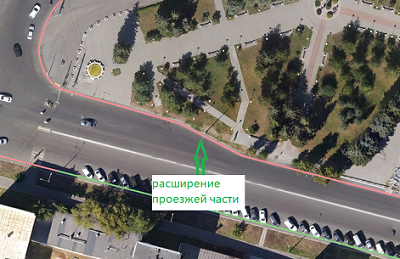
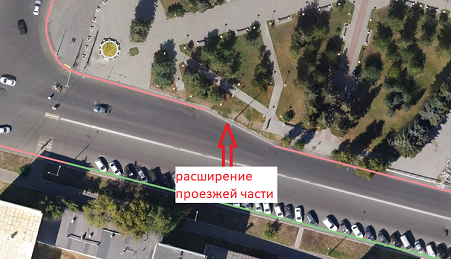
3.8.2.3.4
-
If a line of parking spots is interrupted by an exit from a residential complex or other area perpendicular to the line, it is drawn with a gap that matches the actual borders on the exit.
If the exit from a residential complex or other area is not drawn on the map in accordance with the rules, you can both
split
the line of parallel parking at the location of such an exit or leave its geometry intact and ignore the exit.At the same time, you can't draw a forbidden parking only opposite the exit.

3.8.2.3.5
-
Don't draw linear parking spots if there is a corresponding sign:
-
In tunnels
-
Along class 7 roads and pedestrian paths under construction.
-
Along roads located on closed territories. For example, on the closed territory of Nikolsky Ln.:

-
Don't draw parking in areas where it is forbidden (such as along exit ramps or U-turns or between sections of a two-lane road).
-
Don't draw free parallel parking in areas restricted by a boom gate or on private property.
-
3.8.2.3.6
-
If there are no signs ormarkings, parking along the edge of the roadway is permitted if the distance from this edge to the solid line or to the opposite edge of the roadway exceeds 4.5 meters.
Example of permitted free parking:

3.8.2.3.7
-
The Parking attribute value (free/paid/restricted/allowed/taxi stand) depends on the availability of parking space for cars and taxis (if parking is prohibited for trucks but allowed for cars, the attribute value is
allowed
), as well as on road signs and markings (and in their absence, on traffic rules):-
Free parking — if signs indicate that parking is free.
If you are allowed to park for free more than 40% of the time from 8:00 to 20:00 during the month and the rest of the time parking is prohibited, then indicate that parking is free. Otherwise, mark that parking is forbidden.
-
Paid parking — if there is a paid parking sign, even if there are times when parking there is free (during certain days of the year, not all hours of the day, etc.).
Note
In certain regions, a parking sign by default means that parking is paid (for example, in Tbilisi).
Indicate that parking is paid if there are signs that indicate that you must pay to park at certain times (during even or odd days of the month, etc.) and at other times parking is forbidden.
-
Restricted parking ─
-
If a marking or sign reserves parking for certain categories of individuals (such as the handicapped)
-
If parking is intended for vehicles of a certain type (such as electric cars).
-
If parking along a street is for residents and only employees of neighboring organizations can park their cars there.
-
Parking for customers of restaurants, hotels, etc.
-
-
Forbidden parking — if parking or standing is forbidden.
Note
The parking lot is attributed as Forbidden even if its sign doesn't apply to all groups of people, taxis excepted, and doesn't have an extra description (for example, the
No parking
sign doesn't apply to the disabled). -
Taxi stands ─
-
If there's a
Taxi stand
sign. -
If there's a
Taxi stand
sign with yellow zigzag markings (in this case, draw the parking along the entire length of the markings). -
If there's a road sign prohibiting parking, with an extra description
Except taxi
:
-
-
3.8.2.3.8
-
If parking availability is changed temporarily (during the winter or road construction), edit parking attributes only if new road signs are installed or in accordance with the traffic regulations.
News sources mentioning temporary changes in parking rules can't be the basis for such edits.
3.8.2.3.9
- If a country's traffic code prohibits parking cars within a certain distance of public transport stops, measure the radius from the boundaries of the transport stop pavilion in the absence of road markings and signs that determine the stop's boundaries.
Alert
Don't use editing tools to create new items by dragging existing ones to the appropriate location and changing their size or attributes when you edit lines of parking.